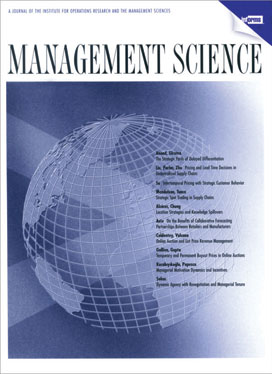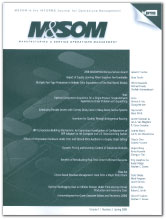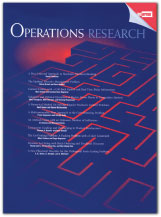Academic articles
Practitioner articles
Working papers
Books
Book chapters
Case studies
Other publications
Subject(s)
Management sciences, decision sciences and quantitative methods
Keyword(s)
social participation, European Social Survey, social capital, informal participation, formal participation, trust
Volume
100
Journal Pages
331–350
Subject(s)
Marketing
Keyword(s)
stakeholder marketing, marketing strategy, triple bottom line
With the permission of the American Marketing Association
Volume
29
Journal Pages
1–3
ISSN (Print)
0743–9156
Subject(s)
Strategy and general management
Keyword(s)
CSR, stakeholders, business case
By engaging in corporate social responsibility (CSR) activities, companies can not only generate favorable stakeholder attitudes and better support behaviors, but also, over the long run, build corporate image, strengthen stakeholder-company relationships, and enhance stakeholders' advocacy behaviors. However, stakeholders' low awareness of and unfavorable attributions towards companies' CSR activities remain critical impediments in companies' attempts to maximize business benefits from their CSR activities, highlighting a need for companies to communicate CSR more effectively to stakeholders. In light of these challenges, a conceptual framework of CSR communication is presented.
© 2010 Blackwell Publishing Ltd and British Academy of Management
Volume
12
Journal Pages
8–19
Subject(s)
Marketing
Keyword(s)
ambiguity, brand preference, decisions under uncertainty, multiattribute choice
We propose that ambiguity aversion, as introduced in the literature on decision making under uncertainty, drives a preference for established brands in multiattribute choices among branded alternatives. Established
brands are those for which belief in quality is held with greater confidence, even if specific attributes might be inferior to those of competing, less-established brands. In five experiments, we examine the role of ambiguity aversion in the preference for dominated, established brands. We first show a correlation between ambiguity aversion (revealed through choices among monetary lotteries) and the preference for established brands. We then show that the preference for established brands is enhanced when ambiguity aversion is made more salient in unrelated preceding lottery choices. Thus, ambiguity aversion carries across choices. In addition,
ambiguity aversion and the preference for established brands are both enhanced when subjects anticipate that others will evaluate their lottery choices. Finally, ambiguous information about brand attributes tends to
increase the preference for established brands.
© 2009 INFORMS
Volume
55
Journal Pages
1933–1941
ISSN (Online)
1526-5501
ISSN (Print)
0025–1909
Subject(s)
Marketing
Keyword(s)
emotions, anger, cognitive appraisal, fairness, ultimatum, bargaining
Although previous research has demonstrated the importance of emotions in ultimatum
bargaining, this research provides a more direct, convergent test of the role of anger in
explaining rejections of unfair offers in ultimatum bargaining. First, using appraisal
theory of emotions, this research examines the extent to which the cognitive appraisal of
unfairness leads to the emotion of anger, which in turn, drives punitive behavior (i.e.,
rejection of offers). Second, this research explores the possibility of decoupling the
emotion of anger from its antecedent appraisal of unfairness in order to attenuate
responders' inclination to reject unfair offers. Third, following the current research
tradition that goes beyond a valence-based approach, we differentiate between the negative emotions of anger and sadness and examine whether it is the specific emotion
of anger that is relevant to the cognitive appraisal of unfairness or the general negative
valence of the emotion.
© 2008 John Wiley & Sons, Ltd.
Volume
22
Journal Pages
475–489
Subject(s)
Marketing
Keyword(s)
R&D competition, patents, new product research, speed-to-market, consumer learning, expectations, diffusion of innovation
JEL Code(s)
M30, M31, C72
Volume
7
Journal Pages
445–481
Subject(s)
Product and operations management
Keyword(s)
Inventory rationing, optimal control, queuing theory
Volume
41
Journal Pages
1096–1109
Subject(s)
Product and operations management
Keyword(s)
advance demand information, production-inventory systems, inventory rationing, make-to-stock
We consider a make-to-stock supplier that operates a production facility with limited capacity. The supplier receives orders from customers belonging to several demand classes. Some of the customer classes share advance demand information with the supplier by announcing their orders ahead of their due date. However, this advance demand information is not perfect because the customer may decide to order prior to or later than the expected due date or may decide to cancel the order altogether. Customer classes vary in their demand rates, expected due dates, cancellation probabilities, and shortage costs. The supplier must decide when to produce and, whenever an order becomes due, whether or not to satisfy it from on-hand inventory. Hence, the supplier is faced with a joint production-control and inventory-allocation problem. We formulate the problem as a Markov decision process and characterize the structure of the optimal policy. We show that the optimal production policy is a state-dependent base-stock policy with a base-stock level that is nondecreasing in the number of announced orders. We show that the optimal inventory-allocation policy is a state-dependent multilevel rationing policy, with the rationing level for each class nondecreasing in the number of announced orders (regardless of whether the class provides advance information). From numerical results, we obtain several insights into the value of advance demand information for both supplier and customers.
© 2009 INFORMS
Volume
11
Journal Pages
128–143
ISSN (Online)
1526–5498
ISSN (Print)
1523-4614
Subject(s)
Product and operations management
Keyword(s)
epidemic control, game theory, optimization
This paper examines how two countries would allocate resources at the onset of an epidemic when they seek to protect their own populations by minimizing the total number of infectives over the entire time horizon. We model this situation as a game between selfish countries, where players strategically allocate their resources in order to minimize the total number of infected individuals in their respective populations during the epidemic. We study this problem when the initial number of infectives is very small, which greatly simplifies the analysis. We show in this framework that selfish countries always allocate their resources so as to bring the effective reproduction ratio below one and avoid a major outbreak. When a major outbreak is avoidable, we further identify the necessary and sufficient conditions under which the individual allocation decisions of selfish countries match the decision that a central planner would make in order to minimize the total number of infectives in the whole population (without distinguishing between countries).
With permission of Elsevier
Volume
222
Journal Pages
1–20
Subject(s)
Management sciences, decision sciences and quantitative methods
Keyword(s)
epidemic control, influenza, Reed-Frost model, supermodular games
Recent epidemiologic studies have suggested that the prophylactic use of antiviral drugs or imperfect vaccines could slow down the spread of an influenza epidemic. Since drug stockpiles are presently scattered in different countries, the outbreak of an epidemic gives rise to a game in which each country must make decisions about how best to allocate its own stockpile in order to protect its population. We develop a two-period multivariate Reed-Frost model to represent the spread of the epidemic within and across countries at its onset. Our model captures three critical sources of uncertainty: the number of initial infections, the spread of the disease, and drug efficacy. We show that for small between-country infection rates, the underlying game is supermodular and that a unique Pareto optimal Nash equilibrium exists. In this equilibrium, some countries give up all their drugs to protect the population where the epidemic first appeared, while all others keep their stockpiles for themselves. Further, we identify sufficient conditions under which the optimal solution of a central planner (such as the World Health Organization) constitutes a Pareto improvement over the decentralized equilibrium, suggesting that countries could agree on an allocation scheme which would benefitt everyone. By contrast, when the central planner's solution does not constitute a Pareto improvement, minimizing the total number of infected persons globally requires some countries to sacrifice part of their own population, which raises intriguing ethical issues. Preliminary numerical studies also indicate that similar results hold for the duration of the pandemic, with the difference that countries seem willing to give up their drug stockpiles for more sets of parameters than in the two-period case.
© 2009 INFORMS
Volume
57
Journal Pages
1320–1332



